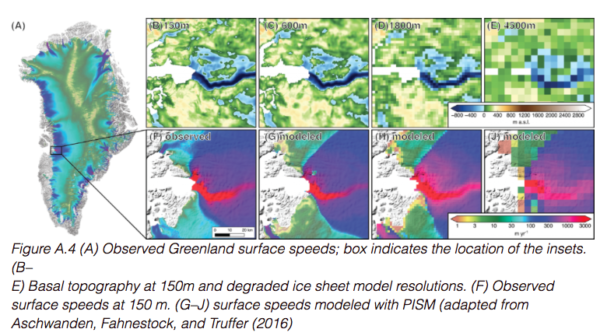In this guest post from Mellanox Technologies, Vice President of Marketing, Gilad Shainer, discusses the University of Alaska Fairbanks use of high performance computing technology in tracking the Earth’s largest ice shelves.
Recently, a chunk of ice the size of Delaware broke off Antarctica’s Larsen C ice shelf. With the help of Mellanox’s High Performance Computing (HPC) solutions, the University of Alaska is conducting fascinating work on ice sheets.

Gilad Shainer, Vice President of Marketing, Mellanox Technologies
Those concerned with what is popularly referred to as, “the fate of humanity” are apt to track comets, asteroids and even the rate of melt of one of earth’s most precious resources, ice sheets. But, as I set out to discuss Mellanox and the University of Alaska Fairbank’s (UAF) fascinating work on ice sheets, the thought came to me that high-tech data centers, and High Performance Computing (HPC) running some of the biggest financial trading centers in the world, were about as far from the vast frozen wild of ice sheets as it gets.
Turns out, the more I looked into it, the more I realized that HPC – and the expansive, pristine ice sheets of our blue planet – are actually very closely aligned. Presently, 10 percent of land area on Earth is covered with glacial ice, including glaciers, ice caps, and the ice sheets of Greenland and Antarctica. This amounts to more than 15 million square kilometers (5.8 million square miles). And it is worthy to note that glaciers store about 75 percent of the world’s fresh water. So, tracking the size and rate of melt for these massive ice sheets is actually very important to humanity. In fact, the Greenland ice sheet occupies about 82 percent of the surface of Greenland, and if melted, would cause sea levels to rise by 7.2 meters. Estimated changes in the mass of Greenland’s ice sheet suggest it is melting at a rate of about 239 cubic kilometers (57.3 cubic miles) per year. Fate of humanity indeed.
[clickToTweet tweet=”With the help of Mellanox’s HPC solutions, the University of Alaska is conducting fascinating work on ice sheets.” quote=”With the help of Mellanox’s HPC solutions, the University of Alaska is conducting fascinating work on ice sheets.”]
Andy Aschwanden, Research Assistant Professor, Geophysical Institute, UAF, is studying the ice flow of the Greenland ice sheet and is on the fast track for credible modeling efforts that will help predict the future evolution of the Greenland ice sheet.

Over the past two decades, the professor reports that large changes in flow have been observed in outlet glaciers, and that the melt rate is speeding up, with a 17 percent increase in ice-sheet wide melt between 2000 and 2005. To track these potentially life altering changes in these outlet glaciers, an ice sheet model is called for. UAF researchers have been hard at work developing the open-source Parallel Ice Sheet Model since 2006, and are genuine pioneers in open-source ice sheet modeling. Development, testing, and cutting edge research on ice sheets, says Aschwanden, goes hand-in-hand with state-of-the-art HPC resources.
Essentially, the simulations needed to track the massive ice sheet’s progress require extremely large resolutions, large outputs and high computational demands – all only available via the formidable computational power found in Mellanox’s HPC computing resources. Such simulations are needed as proof-of-concept; and the HPC resources provided by Mellanox enables routine simulations at ≤1km grid resolution that better resolve the physics of the Greenland ice sheet.

As we know from research being conducted at the University of Alaska Fairbanks, an act of Congress established the Geophysical Institute in 1946. Since that time, the institute has earned an international reputation for studying Earth and its physical environments at high latitudes. The institute now consists of seven major research units and many research support facilities, including space physics and aeronomy; atmospheric sciences; snow, ice, and permafrost; seismology; volcanology; remote sensing; and tectonics and sedimentation.
Essentially, the simulations needed to track the massive ice sheet’s progress require extremely large resolutions, large outputs and high computational demands – all only available via the formidable computational power found in Mellanox’s HPC computing resources.
In January 2017, with support from the M. J. Murdock Charitable Trust, the Geophysical Institute, UAF vice chancellor of research, UAF International Arctic Research Center, and UAF IDeA Network of Biomedical Research Excellence, UAF Research Computing Systems engineers deployed Mellanox InfiniBand solutions across multiple racks to form their HPC system. “This community, condo model project launches a significant change in how high-performance computing resources are offered to the UA community,” said Gwendolyn Bryson, manager of Research Computing Systems at the UAF Geophysical Institute. “Chinook is more capable, more flexible and more efficient than our legacy HPC resources.”
Gilad Shainer is VP of Marketing at Mellanox Technologies. This post originally ran as part of Mellanox Technology’s new blog series, “Our Interconnected Planet.”




